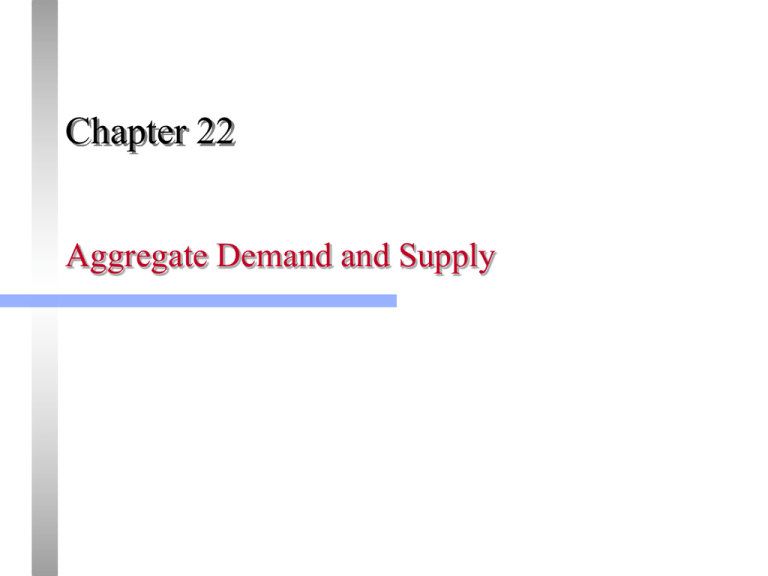
Chapter 22
Aggregate Demand and Supply
Why the Aggregate Demand Curve
Slopes Downward (1)
Aggregate demand (AD) is the economy-wide
demand for goods and services.
Like the market demand curve, the aggregate
demand curve slopes downward, but for different
reasons.
The reasons for its downward slope are price-level
effects:
–
–
–
Wealth Effect (Real Wealth/Real Balances)
Interest Rate Effect
International Trade Effect (Substitution)
2
Copyright © Houghton Mifflin Company. All rights reserved.
Why the Aggregate Demand Curve
Slopes Downward (2)
3
Copyright © Houghton Mifflin Company. All rights reserved.
The Interest Rate Effect
4
Copyright © Houghton Mifflin Company. All rights reserved.
Why the Aggregate Demand Curve
Slopes Downward (4)
5
Copyright © Houghton Mifflin Company. All rights reserved.
The
Aggregate
Demand
Curve
Note that
changes in prices
result in changes
in the aggregate
quantity
demanded.
6
Copyright © Houghton Mifflin Company. All rights reserved.
Factors that Affect AD
AD = C + I + G + XN
Consumption
–
–
–
–
–
Income
Wealth
Expectations
Demographics
Taxes
Investment
–
–
–
–
Government Spending
Net Exports
–
–
–
–
Domestic & Foreign
Income
Domestic & Foreign Prices
Exchange Rates
Government Policy
Interest Rates
Technology
Cost of Capital Goods
Capacity Utilization
7
Copyright © Houghton Mifflin Company. All rights reserved.
Non-price Determinants: Changes in
Aggregate Demand (1)
8
Copyright © Houghton Mifflin Company. All rights reserved.
Nonprice Determinants: Changes in
Aggregate Demand (2)
9
Copyright © Houghton Mifflin Company. All rights reserved.
Non-price Determinants: Changes in
Aggregate Demand (3)
10
Copyright © Houghton Mifflin Company. All rights reserved.
Shifting the
Aggregate
Demand Curve
11
Copyright © Houghton Mifflin Company. All rights reserved.
Effects of a
Change in
Aggregate
Demand
Demand-pull
inflation: rapid
increases in AD
outpace the
growth of AS,
causing price level
increases
(inflation).
Copyright © Houghton Mifflin Company. All rights reserved.
12
Short-run Aggregate Supply
Aggregate Supply (AS) is the total of all
the firm (market) supply curves.
It shows the quantity of real GDP
produced at different price levels.
Short-run AS slopes upward because an
increase in the price level (while
production costs and capital are held
constant on the short-run), means higher
profit margins—firms will want to produce
more.
13
Copyright © Houghton Mifflin Company. All rights reserved.
Aggregate
Supply
14
Copyright © Houghton Mifflin Company. All rights reserved.
Shape of Short-run AS (SRAS)
In the short-run, the capital stock (the number of
factories and machines, etc.) are held constant.
Increasing the number of workers increases
output, but at a diminishing rate.
Diminishing returns manifest as an ever-steeper
SRAS curve.
In the short-run, some prices do not adjust
quickly:
–
–
–
Labor Costs (wages)
Contracted supplies
“Sticky” prices effect the short-run equillibrium
15
Copyright © Houghton Mifflin Company. All rights reserved.
The Shape of
the Short-Run
Aggregate
Supply Curve
16
Copyright © Houghton Mifflin Company. All rights reserved.
The Shape of Long-run AS (LRAS)
Resource costs are NOT fixed.
–
As prices rise, workers will want higher wages
and will eventually get them.
The amount of capital is not fixed—firms
can build new plants and buy new
equipment over the long-run.
In the long-run, AS is set by the
production possibilities curve—the
capacity of the economy, and is not
affected by prices, hence is vertical.
17
Copyright © Houghton Mifflin Company. All rights reserved.
The Shape of the
Long-Run
Aggregate
Supply Curve
18
Copyright © Houghton Mifflin Company. All rights reserved.
Determinants of Aggregate Supply (1)
19
Copyright © Houghton Mifflin Company. All rights reserved.
Determinants of Aggregate Supply (2)
20
Copyright © Houghton Mifflin Company. All rights reserved.
Determinants of Aggregate Supply (3)
21
Copyright © Houghton Mifflin Company. All rights reserved.
Shifting the
Long-Run
Aggregate
Supply Curve
Growth occurs as the
labor force and the
capital stock grow, as
technological
innovation improves
production efficiency.
22
Copyright © Houghton Mifflin Company. All rights reserved.
Changes in
Short-Run
Aggregate
Supply
23
Copyright © Houghton Mifflin Company. All rights reserved.
Effects of a
Change in
Aggregate
Supply
Cost-push
inflation: cost
increases push
AS to the left
(relative to AD),
causing price
level increases
(inflation).
Copyright © Houghton Mifflin Company. All rights reserved.
24
Aggregate
Demand and
Aggregate
Supply
Equilibrium
25
Copyright © Houghton Mifflin Company. All rights reserved.
Aggregate
Demand and
Supply
Equilibrium
26
Copyright © Houghton Mifflin Company. All rights reserved.
27
Copyright © Houghton Mifflin Company. All rights reserved.
28
Copyright © Houghton Mifflin Company. All rights reserved.
29
Copyright © Houghton Mifflin Company. All rights reserved.
30
Copyright © Houghton Mifflin Company. All rights reserved.
31
Copyright © Houghton Mifflin Company. All rights reserved.
32
Copyright © Houghton Mifflin Company. All rights reserved.
Economic Insight:
OPEC and
Aggregate Supply
33
Copyright © Houghton Mifflin Company. All rights reserved.







